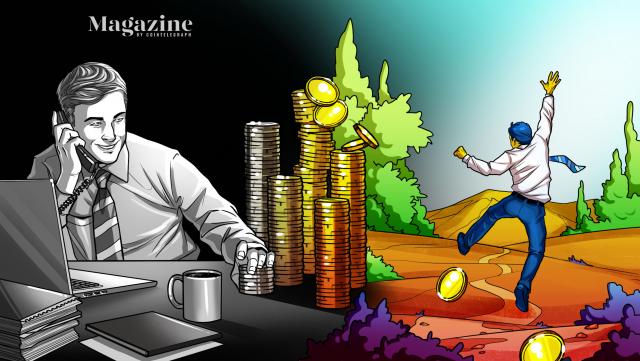Late last spring, as the extended family enjoyed a leisurely weekend dodging hoons on the Teewah Beach speedway while attempting to catch a tailor or two, I took a break in the shade and engaged in conversation with my financial adviser, who is also a grandson.
“Get in now, Poppy,” he was saying, “It’s going through the roof!”
He was referring, of course, to cryptocurrency, in which he was having a fairly serious dabble for a 14-year-old playing the market on his pocket money, although all too soon his entire fund would be scammed.
But on that lovely October afternoon, back at the borrowed beach house I pulled out the Macbook and by nightfall Poppy had a sizeable portfolio of things with funny names that didn’t seem to bear any relation to anything real or tangible, but were almost certainly going to make me rich beyond my wildest dreams.
OK, drink had been taken – me, not my teenaged adviser – but I’m not going to blame that. It was fun, like an edgy game of Snakes and Ladders. And when it all started to go south a few weeks later, so much so that I stopped looking at my apps and still haven’t – it brought to mind another distant memory. Does anyone else remember the Airplane Game?
With a name like that it could have only come from one place, but by the late ‘80s it was everywhere.
It was a pyramid scheme, pure and simple, but if you asked any of the coke-crazed loonies who came knocking on your door at midnight trying to sell you a ticket for a couple of grand, it absolutely, positively wasn’t.
Interestingly, cocaine seemed to be a major driver in the scheme, presumably because people who were prepared to pay $200 to stay up all night grinding their teeth needed money and had no scruples about how they got it.
Involving a captain at the pointy end and co-pilots, cabin crew and passengers at descending levels, the game/scheme/scam paid out the captain when the plane filled, and everyone stepped up a level, but unless you bought in at or near the top you were never going to get your money back.
Its birthplace was the bayous of southern Florida, but even those old swamp-dogs had picked up on it by 1987, as the South Florida Sun-Sentinel reported: “In South Florida’s newest and hottest pyramid scheme, tickets cost $1500, and while the pilot stands to make $12,000, most of the passengers get taken for a ride. ‘It’s greed, big-time greed,’ said an undercover agent for the Palm Beach County Sheriff’s Office. ‘I don’t feel sorry for them a bit. Nobody’s twisting their arms.’”
Of course, it was a simpler time – no smart phones, no internet – but greed is good was the motto for the times, much as it is in the 2020s.
Except we had a better understanding of what an airplane was, perhaps than we do a blockchain or a non-fungible token. And today boofheads with nose rings are sucking you in on social media, as opposed to midnight doorknockers.
Around the same time that my financial adviser was pitching me crypto on the beach, Noosa retiree Geoffrey Mallinson was firing off an angry letter to our Federal MP Llew O’Brien about “the greatest con in the history of mankind”.
Geoff didn’t hold back in calling out Bitcoin and all its acolytes for what he labelled “fraudulent acts”, and demanding that the federal government act “to ensure that the public not invest in these scams”.
Geoff Mallinson had to wait more than six months for a Ministerial response, and when it came last month from Jane Hume, the then-Minister for the Digital Economy, it was pretty lukewarm.
“The crypto-asset ecosystem [the what?] is complex and continually evolving. The Government and regulators continue to monitor developments … both in Australia and overseas, to ensure that risks are mitigated as appropriate while balancing potential benefits. However, the Government does not intend to ban bitcoin or advise the public against investing.”
The Minister went to say how excited she was about the potential of blockchain technology across the economy, before reminding Geoff that, back in December, the Government had “committed to a range of measures to create a fit-for-purpose financial regulatory regime … [which] will provide appropriate protections for consumers and investors”.
This was last month. Did the Minister have no idea that the whole world was crying out, “The emperor’s got no clothes!”.
It was around this time that I crossed paths with Geoff Mallinson and found him to be a likeable bloke, if a little obsessive about stopping the “greatest fraud in history”.
But every day since our meeting in my office, the news on crypto has gotten worse.
Even its greatest media supporters are now conceding that we are witnessing the start of a virtual bloodbath from which only the biggest and strongest players, like Bitcoin and Ethereum, might emerge bruised and bloodied but still in business.
As of the start of this month, there were more than 19,000 cryptocurrencies on the market and dozens of blockchains whose technology backs them up, but the recent collapse of the supposedly stable coins, Terra and Luna sent shockwaves through the market, has thrust a spotlight on the thousands of cryptocurrencies in existence and whether they will all survive.
The May crash was one of cryptocurrency’s biggest on record, sending the price of bitcoin plummeting to below $US27,000, dragging down the entire market and wiping out hundreds of billions of dollars in value overnight. In one day alone, more than $400 billion was wiped off the market.
But why? Or more to the point, why now?
“As a result of sharply higher inflation and interest rates, the great unregulated cryptocurrency Ponzi scheme has finally started to unravel,” the Australian Financial Review’s Christopher Joye wrote in the middle of May as the whole thing started to unravel.
He said it “beggars belief” that these financial products had been pushed on “naive consumers” with little regulatory protection in place, citing the Securities and Exchange Commission in the US, the Financial Conduct Authority in the UK and ASIC in Australia as “missing in action”.
When it comes to explaining the incredible popularity of crypto, Joye probably hit the nail on the head when he noted: “The key drivers of the crypto craze were interest rates on conventional cash going to zero during the pandemic, while at the same time governments poured trillions of dollars of cash into households’ savings accounts in an effort to stimulate greater spending, investment and speculation.”
Similar financial conditions applied, albeit on a much smaller scale, when the Airplane Game was reaching its flame-out.
At the end of May, consumer advocates Choice reported that one in nine Australians had bought cryptocurrencies in the past year, with that number expected to keep rising.
Half of them saw crypto as a long-term investment, rather than short term speculation, and two in five saw it as a diversification of their portfolio, their research revealed. This pointed to a serious and immediate need for better market regulation and consumer protection, Choice concluded.
Around the same time the ABC’s Four Corners delivered a damning global indictment on crypto through interviews with the world’s leading opponents, including New York lawyer David Scott, whose firm has launched a multi-million-dollar class action against a scheme that used major celebrities to promote a crypto token.
“It’s the wild west, because it is unregulated,” he said, “and because of that lack of regulation, there are many opportunities for people to lose their money. To our mind, as we alleged in our complaint, it appears to be a classic pump and dump scheme.”
Four Corners also interviewed 28-year-old American Molly White, who has emerged as the key player in attacking crypto across social media platforms.
As she told the Washington Post, “Most of my disdain is reserved for the big players who are marketing this to a mainstream audience as though it’s an investment, often promising to be a ticket out of a really tough financial spot for people who don’t have many options. It’s very predatory”.
The Post described White as “a rare figure who can manoeuvre the technically complex, meme-filled world of crypto, translating it into digestible prose.”
At last, although maybe a little late, a “crypto bill” is set to be introduced in the US Congress this month with a strong regulatory framework over at least part of the market.
What our new Federal Labor government will do remains to be seen.








